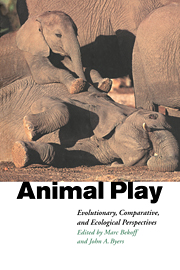Book contents
- Frontmatter
- Contents
- List of contributors
- Introduction
- 1 The evolutionary origins of play revisited: lessons from turtles
- 2 Play in common ravens (Corvus corax)
- 3 Object play by adult animals
- 4 Kangaroos at play: play behaviour in the Macropodoidea
- 5 Intentional communication and social play: how and why animals negotiate and agree to play
- 6 Structure-function interface in the analysis of play fighting
- 7 Sparring as play in young pronghorn males
- 8 Squirrel monkey play fighting: making the case for a cognitive training function for play
- 9 Self assessment in juvenile play
- 10 Biological effects of locomotor play: getting into shape, or something more specific?
- 11 Neurobiological sustrates of play behavior: glimpses into the structure and function of mammalian playfulness
- 12 Play as an organizing principle: clinical evidence and personal observations
- Index
5 - Intentional communication and social play: how and why animals negotiate and agree to play
Published online by Cambridge University Press: 20 November 2009
- Frontmatter
- Contents
- List of contributors
- Introduction
- 1 The evolutionary origins of play revisited: lessons from turtles
- 2 Play in common ravens (Corvus corax)
- 3 Object play by adult animals
- 4 Kangaroos at play: play behaviour in the Macropodoidea
- 5 Intentional communication and social play: how and why animals negotiate and agree to play
- 6 Structure-function interface in the analysis of play fighting
- 7 Sparring as play in young pronghorn males
- 8 Squirrel monkey play fighting: making the case for a cognitive training function for play
- 9 Self assessment in juvenile play
- 10 Biological effects of locomotor play: getting into shape, or something more specific?
- 11 Neurobiological sustrates of play behavior: glimpses into the structure and function of mammalian playfulness
- 12 Play as an organizing principle: clinical evidence and personal observations
- Index
Summary
Social play: evolution, pretense, and the cognitive turn
To return to our immediate subject: the lower animals, like man, manifestly feel pleasure and pain, happiness and misery. Happiness is never better exhibited than by young animals, such as puppies, kittens, lambs, etc., when playing together, like our own children. Even insects play together, as has been described by that excellent observer, P. Huber, who saw ants chasing and pretending to bite each other, like so many puppies.
(Charles Darwin 1871/1936, p. 448)Pierre Huber (1810, p. 148), in his book about the behavior of ants, claims that if one were not accustomed to treating insects as machines one would have trouble explaining the social behavior of ants and bees without attributing emotions to them. Although we shall skirt the issue of emotion, many observers would agree that animals play because it is fun for them to do so. But even if the issue of emotions is set aside, readers conditioned by the scruples of modern psychology are likely to be skeptical of Darwin's ready acceptance that Huber observed ants playing. Play, as the quotation above indicates, seems to involve pretense, and pretense is commonly thought to require more sophisticated intentions than are usually attributed to ants. How could Huber have seen or inferred pretense from the behavior of the ants? And how could he be sure that the observed behavior was not, in fact, directed toward some very specific and immediate function? These questions raise the difficult issue of what play is, or, as biologists are wont to put it, how to define ‘play’.
- Type
- Chapter
- Information
- Animal PlayEvolutionary, Comparative and Ecological Perspectives, pp. 97 - 114Publisher: Cambridge University PressPrint publication year: 1998
- 103
- Cited by

